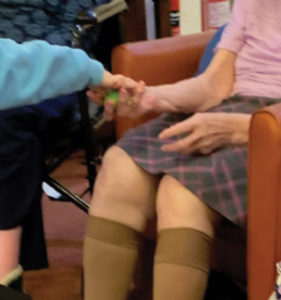
by Marsha Dann
Lead Teacher, Play B C Preschool
Who was not enamoured when Channel 4 first brought preschoolers together with residents in a retirement village in 2017 for ‘Old People’s Home for 4 Year Olds’? While there had already been much to indicate that intergenerational interaction was positive, this six week experiment showed that afterwards 80% of the older people scored better on tests of cognition, mood and depression than they had at the outset. There were improvements in physical skills such as balance and mobility and beautiful relationships blossomed between the old and the young too. When the series returned to our screens in 2018 for a 10 week study, this time, the outcomes were measured for the children as well. Child expert Alistair Bryce Clegg found that the children made unexpected progress in areas of empathy, language, independence and imagination.
Sadly, Britain which has a steadily ageing population has become one of the most age segregated countries in the world, according to research, by United for All Ages and the Intergenerational Foundation. As our society develops the old and the young are becoming more separated with fewer opportunities for them to interact. Statistics from a recent Intergenerational Foundation report, suggest that children living in urban areas have only a 5% chance of having someone aged over 65 living in their area. Living apart damages intergenerational relations and makes it harder for the old and the young to understand one another. Additionally it can lead to marginalisation and exclusion.
Age UK says that more than a million of our older people feel lonely. International research project Together Old and Young (TOY) demonstrates that social engagement between generations is important for us all. Intergenerational learning can help to bridge the gaps between different social groups. Older people have wisdom, heritage and experience to pass on and young children are creative and have original ways of thinking. Both age groups have much to learn from each other and their interaction appears to offer benefits including enhanced health wellbeing and the fostering of social cohesion, acceptance and appreciation of diversity. Older people can experience enhanced feelings of purpose and self-esteem and younger people can view old age more positively.
Putting it into practice
My mum is 80 years old and regularly volunteers in our preschool. Although her way of interacting with the children may not be as tactful as the practitioners, particularly when it comes to matters of discipline, the children value her no nonsense approach and enjoy her company as much as she enjoys theirs. Seeing them together fuelled my desire to get an intergenerational project off the ground, something I had been keen to do since learning about co-located early years and elder care facilities such as Mount Pleasant in America and watching the ‘Old People’s Home for 4 Year Olds’. Eager to discover more, I undertook an online course delivered by TOY aimed at bringing under eights and over 65s together. The course materials explored intergenerational learning and how it could be applied in a meaningful way, in a range of contexts. I learned that the sharing of experiences and relationship building was one of a number of effective approaches to intergenerational interaction.
With this in mind, I got in contact with a local Afro-Caribbean heritage association and invited some members to participate in a short programme of African drumming alongside some of our children. Old and young enjoyed the sessions and although we were not able to sustain it on a longer term basis, it is definitely something we would repeat. Our next opportunity came when we were invited by a local drama group to join in a project with a local care home that involved monthly visits to participate in dramatic story telling and play activities with the residents. After a term’s worth of visits it can be seen already that they have had a huge impact. The children, including one who has a diagnosis of autistic spectrum disorder and another who is a selective talker, really enjoy seeing their ‘grandfriends’. They have steadily gained confidence and have become much more interactive with the residents. The residents themselves are always thrilled to see the children. The number of them becoming involved has grown and one of the highlights has been witnessing one lady who is reported as being uncommunicative, smile when a child handed her a scarf so that she could join in the fun.
Engaging with the residents at the care home has supported the children’s personal and social development and broadened their experiences. They view their ‘grandfriends’ as capable, fun and very special. If you can find an opportunity for your child to engage with an older person, grab it with both hands, you will be glad you did.











